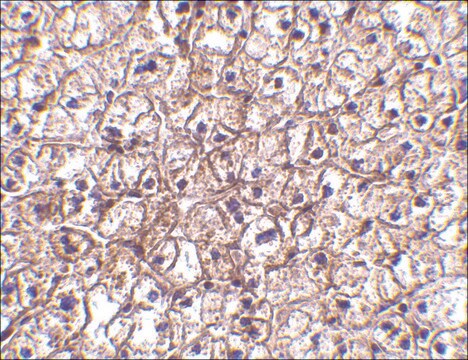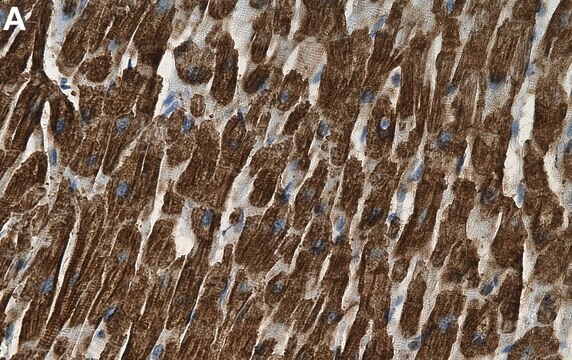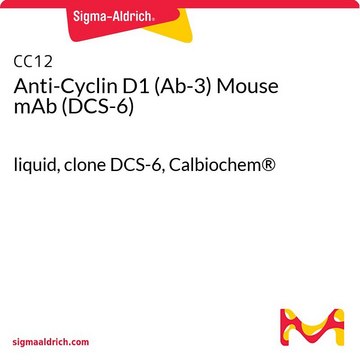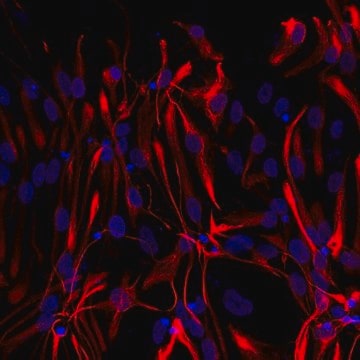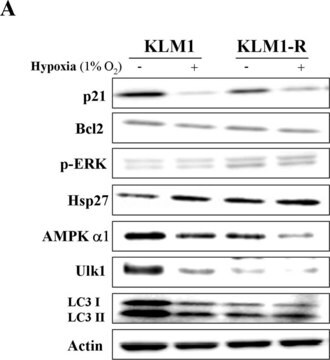MABF938
Anti-MxA, clone M143 (CL143)
clone CL143, from mouse
Synonim(y):
MxA, IFI-78K, Interferon-induced GTP-binding protein Mx1, Interferon-induced protein p78, Myxoma resistance protein 1, Myxovirus resistance 1, MX1
About This Item
Polecane produkty
pochodzenie biologiczne
mouse
Poziom jakości
forma przeciwciała
purified immunoglobulin
rodzaj przeciwciała
primary antibodies
klon
CL143, monoclonal
reaktywność gatunkowa
guinea pig, human, mouse, rat
metody
flow cytometry: suitable
immunohistochemistry: suitable (paraffin)
western blot: suitable
izotyp
IgGκ
numer dostępu NCBI
numer dostępu UniProt
Warunki transportu
wet ice
docelowa modyfikacja potranslacyjna
unmodified
informacje o genach
human ... MX1 (4599)
Powiązane kategorie
Opis ogólny
Specyficzność
Immunogen
Zastosowanie
Immunohistochemistry Analysis: Representative lots detected MxA immunoreactivity in patients-derived skin lesion samples using paraffin-embedded tissue sections (Urosevic, M., et al. (2007). J. Clin. Invest. 117(10): 2834–2846; Urosevic, M., et al. (2005). J. Natl. Cancer Inst. 97(15):1143-1153).
Flow Cytometry Analysis: A representative lot detected MxA expression in MxA-transfected U-87-H4 and U-87-D11, but not untransfected U-87-K4 human gliobastoma cells (Schneider-Schaulies, S., et al. (1994). J. Virol. 68(11):6910-6917).
Western Blotting Analysis: A representative lot detected a robust MxA induction in the lung tissue from guinea pigs that recieved intranasal administration of recombinant human alpha-IFN (Van Hoeven, N., et al. (2009). J. Virol. 83(7): 2851–2861).
Western Blotting Analysis: A representative lot detected a time-dependent MxA induction in the lung tissue from rats following intraperitoneal Seoul virus inoculation (Hannah, M.F., et al. (2008). Brain Behav Immun. 22(4):503-516).
Immunoprecipitation Analysis: A representative lot immunoprecipitated MxA from murine MxA-expressing Swiss 3T3 cells (clone 4.5.15) (Flohr, F., et al. (1999). FEBS Lett. 463(1-2):24-28).
Inflammation & Immunology
Immunoglobulins & Immunology
Jakość
Western Blotting Analysis: 0.5 µg/mL of this antibody detected MxA in 10 µg of Swiss 3T3 (clone 4.5.15) cell lysate.
Opis wartości docelowych
Postać fizyczna
Przechowywanie i stabilność
Inne uwagi
Oświadczenie o zrzeczeniu się odpowiedzialności
Nie możesz znaleźć właściwego produktu?
Wypróbuj nasz Narzędzie selektora produktów.
Kod klasy składowania
12 - Non Combustible Liquids
Klasa zagrożenia wodnego (WGK)
WGK 1
Temperatura zapłonu (°F)
Not applicable
Temperatura zapłonu (°C)
Not applicable
Certyfikaty analizy (CoA)
Poszukaj Certyfikaty analizy (CoA), wpisując numer partii/serii produktów. Numery serii i partii można znaleźć na etykiecie produktu po słowach „seria” lub „partia”.
Masz już ten produkt?
Dokumenty związane z niedawno zakupionymi produktami zostały zamieszczone w Bibliotece dokumentów.
Nasz zespół naukowców ma doświadczenie we wszystkich obszarach badań, w tym w naukach przyrodniczych, materiałoznawstwie, syntezie chemicznej, chromatografii, analityce i wielu innych dziedzinach.
Skontaktuj się z zespołem ds. pomocy technicznej
